Unit 3 Festivals and customs reading 课件(共17张)-2025-2026学年译林版(2019)必修第二册
文档属性
| 名称 | Unit 3 Festivals and customs reading 课件(共17张)-2025-2026学年译林版(2019)必修第二册 | 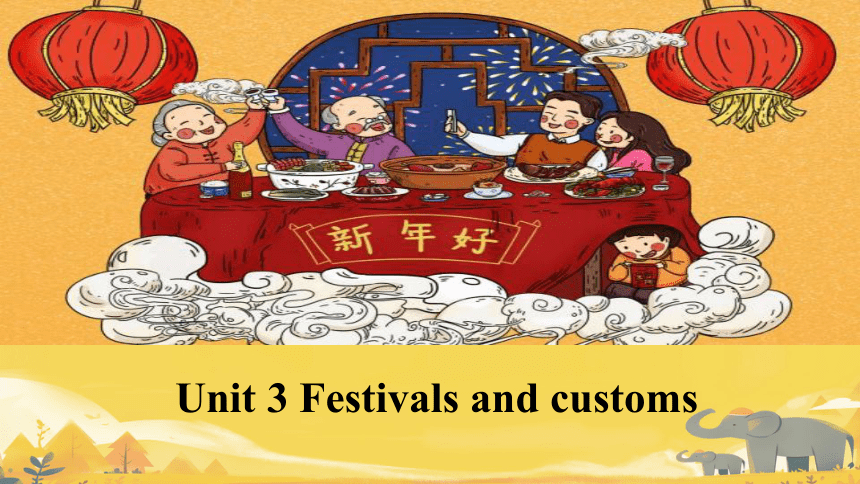 | |
| 格式 | pptx | ||
| 文件大小 | 11.1MB | ||
| 资源类型 | 教案 | ||
| 版本资源 | 牛津译林版(2019) | ||
| 科目 | 英语 | ||
| 更新时间 | 2025-06-16 22:54:26 | ||
图片预览

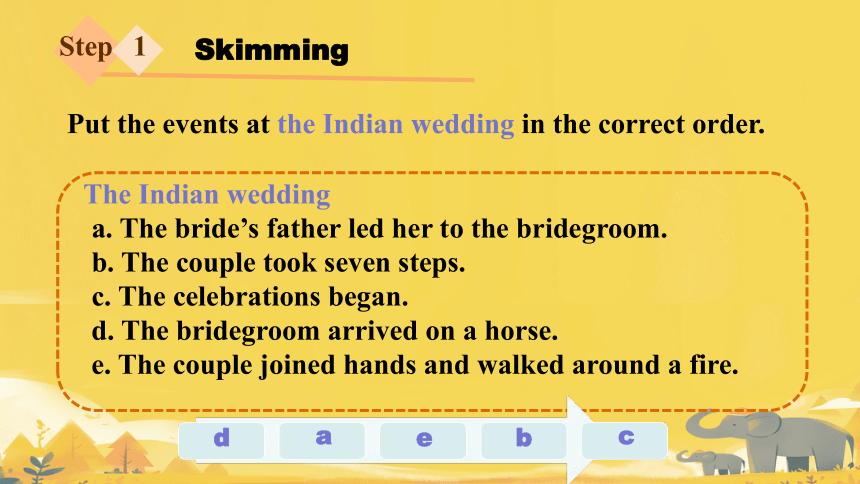
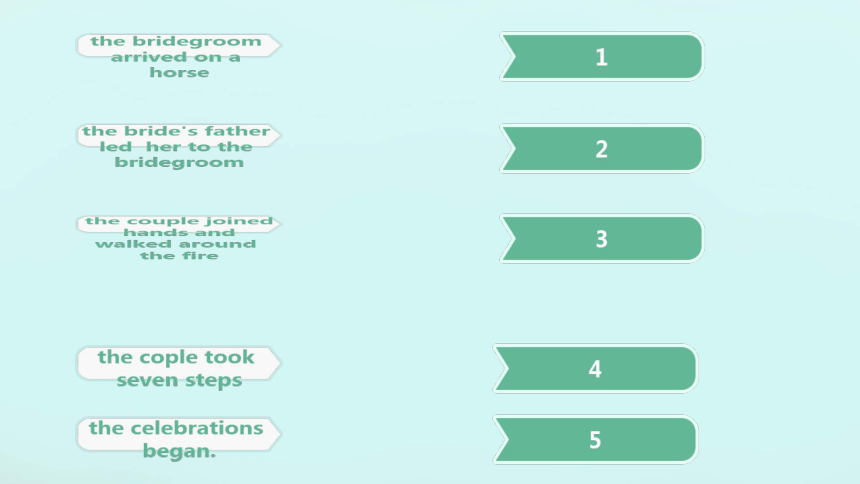
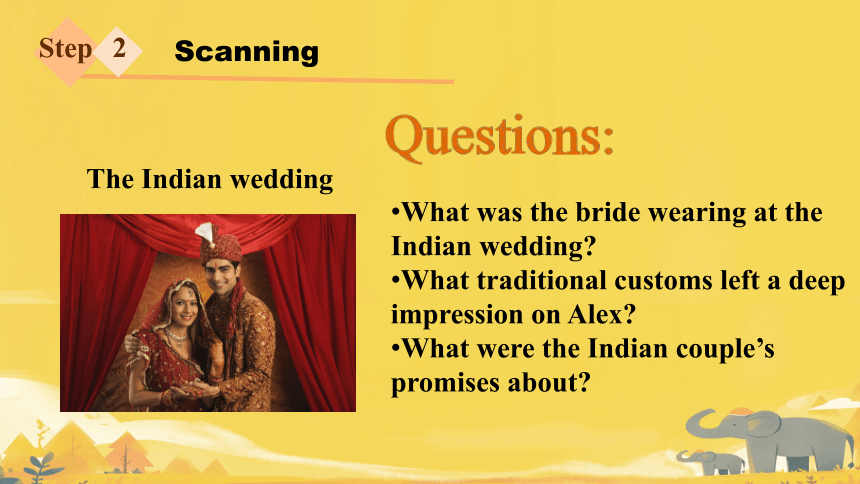

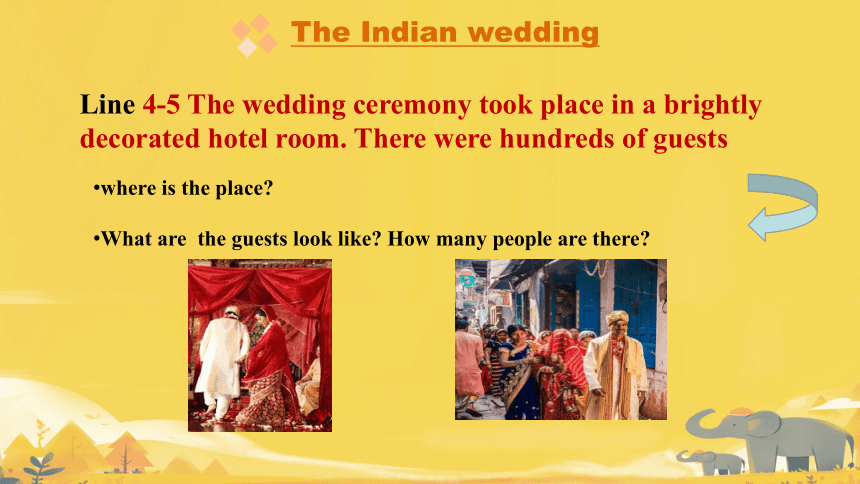

文档简介
(共17张PPT)
Unit 3 Festivals and customs
Put the events at the Indian wedding in the correct order.
The Indian wedding
a. The bride’s father led her to the bridegroom.
b. The couple took seven steps.
c. The celebrations began.
d. The bridegroom arrived on a horse.
e. The couple joined hands and walked around a fire.
d
a
e
b
c
1
Step
Skimming
What was the bride wearing at the Indian wedding
What traditional customs left a deep impression on Alex
What were the Indian couple’s promises about
The Indian wedding
2
Step
Scanning
where is the place
What are the guests look like How many people are there
Line 4-5 The wedding ceremony took place in a brightly decorated hotel room. There were hundreds of guests
The Indian wedding
where is the place
What are the guests look like How many people are there
What was the bride wearing at the Indian wedding
She was wearing an eye-catching red silk sari.
The Indian wedding
Line 5-6 According to tradition, the bride was wearing an eye-catching red silk sari.
What traditional customs left a deep impression on Alex
The bridegroom’s entrance on a beautiful white horse and the part when
the bride’s father proudly led his daughter to her husband.
The Indian wedding
Line8 One was the bridegroom’s entrance on a beautiful white horse.
Line9 Another was the part when Nadim’s father proudly led his …
What were the Indian couple’s promises about
The promises were about how they were going to support each other and live together happily.
The Indian wedding
Line 14 …promise about how they were going to support each other and live together happily.
Customs tell a man who he is, where he belongs, what he must do.
-- Robert A. Heinlein
风俗习惯告诉一个人他是谁,属于哪里,必须做什么。
Today's harvest
Characteristics
of the feature article
(专题报道文体特征)
Reading for appreciation
It is just past five o’clock on the Chinese New Year’s Eve, and the dinner table ___ already _____________ (铺满了) white china plates and bowls, full of all sorts of dishes: chicken, duck, pork, fish and vegetables. Luo Yan, 29, ____ (掀起) the cover of a large bowl to __________ (闻) the rich smell of the soup his wife and mother had prepared. Luo Yan’s son, Bofeng, happily _____________ (咬了一口) the chicken his grandfather ____________ (挑选) for him.
is
covered with
lifts
breathe in
takes a bite of
has selected
Reading for appreciation
Detailed and vivid ______ descriptions
The author uses the present tense to ___________________________.
make readers feel on the scene
action
Reading for appreciation
Rich ________ to get readers involved
feelings
Six-year-old Bofeng has not seen his grandparents for almost a year, and he is full of _________________ (喜悦与激动). Indeed, the whole family couldn't be _________(幸福) to be together. Despite the cold outside, their happy faces fill the air with ________(温暖) while _______(欢快的) laughter rings throughout the house. (L7-10)
During the five-hour trip, they chatted ________(兴奋地) with each other, their minds full of thoughts about their ______(惬意的) home. (L15–16)
On their arrival, they find Luo’s parents _______(殷切地) waiting for them. (L 17)
joy and excitement
happier
warmth
merry
excitedly
eagerly
sweet
The whole village is lit up with colourful fireworks. All over the country, people are celebrating their _____________, celebrating their family’s ___________, and celebrating their nation’s ________.
good fortune
togetherness
strength
Reading for appreciation
Deep meanings to show the ______
It implies that Chinese people are living a happy life and feel ______ of their great country. It also suggests that every family’s happiness _____________ the country’s greatness and the country’s strength __________ every family’s happiness.
proud
contributes to
guarantees
theme
Summary
1. Customs tell a man ____ he is, ____he belongs, ____ he must do.
2. Traditional festivals teach us a lot about our n_____'s history.
3. Traditional festivals enable us to learn more
about _____ _______ _______.
4. Traditional festivals are a source of
______ _______ and help shape our
_______ _______.
5. It is the duty of everyone of us to protect them for the generations to come.
1. the Chinese New Year's Eve 11. eat snacks
2. china plates and bowls 12. set off firecrackers
3. all sorts of dishes: pork 13. colorful fireworks
4. Bofeng happily takes a bite of the chicken his grandfather has selected for him.
5. settle in big cities
6. The high-speed train has made it much more convenient for them to go back home.
7. the neat designs of ...
8. the Spring Festival couplets
9. represent joy, luck and happiness
10. the hours until Midnight go slowly by 14. good fortune
Unit 3 Festivals and customs
Put the events at the Indian wedding in the correct order.
The Indian wedding
a. The bride’s father led her to the bridegroom.
b. The couple took seven steps.
c. The celebrations began.
d. The bridegroom arrived on a horse.
e. The couple joined hands and walked around a fire.
d
a
e
b
c
1
Step
Skimming
What was the bride wearing at the Indian wedding
What traditional customs left a deep impression on Alex
What were the Indian couple’s promises about
The Indian wedding
2
Step
Scanning
where is the place
What are the guests look like How many people are there
Line 4-5 The wedding ceremony took place in a brightly decorated hotel room. There were hundreds of guests
The Indian wedding
where is the place
What are the guests look like How many people are there
What was the bride wearing at the Indian wedding
She was wearing an eye-catching red silk sari.
The Indian wedding
Line 5-6 According to tradition, the bride was wearing an eye-catching red silk sari.
What traditional customs left a deep impression on Alex
The bridegroom’s entrance on a beautiful white horse and the part when
the bride’s father proudly led his daughter to her husband.
The Indian wedding
Line8 One was the bridegroom’s entrance on a beautiful white horse.
Line9 Another was the part when Nadim’s father proudly led his …
What were the Indian couple’s promises about
The promises were about how they were going to support each other and live together happily.
The Indian wedding
Line 14 …promise about how they were going to support each other and live together happily.
Customs tell a man who he is, where he belongs, what he must do.
-- Robert A. Heinlein
风俗习惯告诉一个人他是谁,属于哪里,必须做什么。
Today's harvest
Characteristics
of the feature article
(专题报道文体特征)
Reading for appreciation
It is just past five o’clock on the Chinese New Year’s Eve, and the dinner table ___ already _____________ (铺满了) white china plates and bowls, full of all sorts of dishes: chicken, duck, pork, fish and vegetables. Luo Yan, 29, ____ (掀起) the cover of a large bowl to __________ (闻) the rich smell of the soup his wife and mother had prepared. Luo Yan’s son, Bofeng, happily _____________ (咬了一口) the chicken his grandfather ____________ (挑选) for him.
is
covered with
lifts
breathe in
takes a bite of
has selected
Reading for appreciation
Detailed and vivid ______ descriptions
The author uses the present tense to ___________________________.
make readers feel on the scene
action
Reading for appreciation
Rich ________ to get readers involved
feelings
Six-year-old Bofeng has not seen his grandparents for almost a year, and he is full of _________________ (喜悦与激动). Indeed, the whole family couldn't be _________(幸福) to be together. Despite the cold outside, their happy faces fill the air with ________(温暖) while _______(欢快的) laughter rings throughout the house. (L7-10)
During the five-hour trip, they chatted ________(兴奋地) with each other, their minds full of thoughts about their ______(惬意的) home. (L15–16)
On their arrival, they find Luo’s parents _______(殷切地) waiting for them. (L 17)
joy and excitement
happier
warmth
merry
excitedly
eagerly
sweet
The whole village is lit up with colourful fireworks. All over the country, people are celebrating their _____________, celebrating their family’s ___________, and celebrating their nation’s ________.
good fortune
togetherness
strength
Reading for appreciation
Deep meanings to show the ______
It implies that Chinese people are living a happy life and feel ______ of their great country. It also suggests that every family’s happiness _____________ the country’s greatness and the country’s strength __________ every family’s happiness.
proud
contributes to
guarantees
theme
Summary
1. Customs tell a man ____ he is, ____he belongs, ____ he must do.
2. Traditional festivals teach us a lot about our n_____'s history.
3. Traditional festivals enable us to learn more
about _____ _______ _______.
4. Traditional festivals are a source of
______ _______ and help shape our
_______ _______.
5. It is the duty of everyone of us to protect them for the generations to come.
1. the Chinese New Year's Eve 11. eat snacks
2. china plates and bowls 12. set off firecrackers
3. all sorts of dishes: pork 13. colorful fireworks
4. Bofeng happily takes a bite of the chicken his grandfather has selected for him.
5. settle in big cities
6. The high-speed train has made it much more convenient for them to go back home.
7. the neat designs of ...
8. the Spring Festival couplets
9. represent joy, luck and happiness
10. the hours until Midnight go slowly by 14. good fortune
